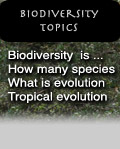


 |
Evolution
In these pages we'll learn:
- What is Evolution
- Differences between macro and micro evolution
- Major concepts
- Evolution links
Definition:
The scientific definition of evolution is ‘a changing of the frequency of alleles in a population’. On a simplified basis, you can think of an allele as a trait (sometimes this view is too simple), such as eye or hair color. Populations are the individuals of one species that occur in a given area. Thus, if the percentage of people with blue eyes in Sweden (given that nobody goes in or out) begins to change, then one can say evolution is occurring.
Simple evolution, according to our scientific explanation is not very difficult to envision. In fact, it is easy to prove that this happens (as has been done many times). Where the controversy comes in is with the definitions of micro-evolution and macro-evolution. Thus, it is important to understand the difference.
Micro-evolution is a small scale change, as given by our example of eye color changes. Macro-evolution is evolution on a large scale. It includes the concepts of birds coming from dinosaurs, and reptiles from fish. The debate that surrounds macro-evolution is very large, mostly because macro-evolution, in itself, is impossible to prove, but is simply created through an extrapolation of the small changes we see around us (micro-evolution), and similarities between species – which most people agree is enough to prove the theory.

